Equality Act 2010 and Employee Rights: A Case Study
VerifiedAdded on 2023/05/28
|11
|2850
|392
AI Summary
This article discusses the Equality Act 2010 and employee rights in a case study. It covers the grounds for discrimination, types of discrimination, and the Burchell test. It also provides advice on how to handle grievances in the workplace and how to avoid unfair dismissal.
Contribute Materials
Your contribution can guide someone’s learning journey. Share your
documents today.

Equality act 2010
Project
Project
Secure Best Marks with AI Grader
Need help grading? Try our AI Grader for instant feedback on your assignments.

1 | P a g e
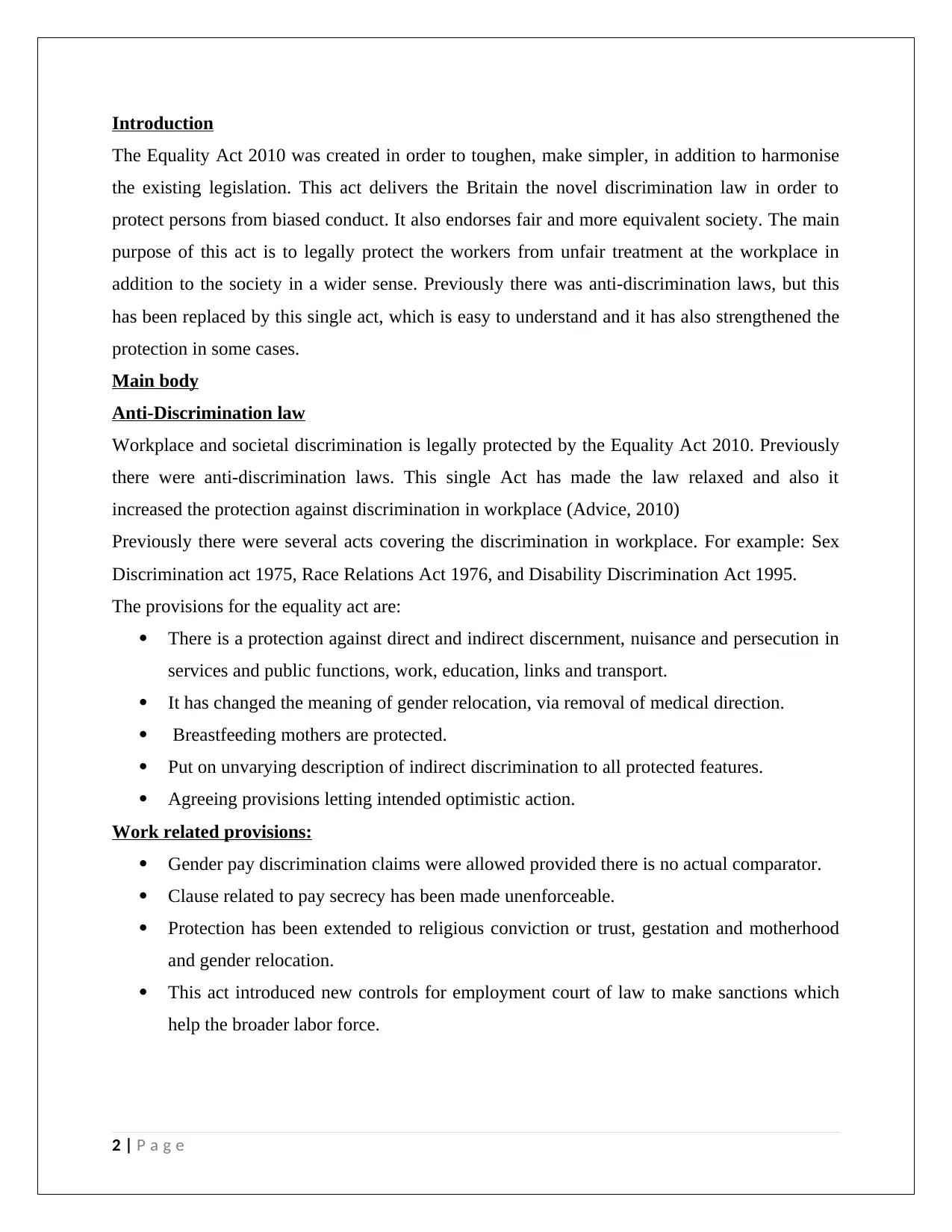
Introduction
The Equality Act 2010 was created in order to toughen, make simpler, in addition to harmonise
the existing legislation. This act delivers the Britain the novel discrimination law in order to
protect persons from biased conduct. It also endorses fair and more equivalent society. The main
purpose of this act is to legally protect the workers from unfair treatment at the workplace in
addition to the society in a wider sense. Previously there was anti-discrimination laws, but this
has been replaced by this single act, which is easy to understand and it has also strengthened the
protection in some cases.
Main body
Anti-Discrimination law
Workplace and societal discrimination is legally protected by the Equality Act 2010. Previously
there were anti-discrimination laws. This single Act has made the law relaxed and also it
increased the protection against discrimination in workplace (Advice, 2010)
Previously there were several acts covering the discrimination in workplace. For example: Sex
Discrimination act 1975, Race Relations Act 1976, and Disability Discrimination Act 1995.
The provisions for the equality act are:
There is a protection against direct and indirect discernment, nuisance and persecution in
services and public functions, work, education, links and transport.
It has changed the meaning of gender relocation, via removal of medical direction.
Breastfeeding mothers are protected.
Put on unvarying description of indirect discrimination to all protected features.
Agreeing provisions letting intended optimistic action.
Work related provisions:
Gender pay discrimination claims were allowed provided there is no actual comparator.
Clause related to pay secrecy has been made unenforceable.
Protection has been extended to religious conviction or trust, gestation and motherhood
and gender relocation.
This act introduced new controls for employment court of law to make sanctions which
help the broader labor force.
2 | P a g e
The Equality Act 2010 was created in order to toughen, make simpler, in addition to harmonise
the existing legislation. This act delivers the Britain the novel discrimination law in order to
protect persons from biased conduct. It also endorses fair and more equivalent society. The main
purpose of this act is to legally protect the workers from unfair treatment at the workplace in
addition to the society in a wider sense. Previously there was anti-discrimination laws, but this
has been replaced by this single act, which is easy to understand and it has also strengthened the
protection in some cases.
Main body
Anti-Discrimination law
Workplace and societal discrimination is legally protected by the Equality Act 2010. Previously
there were anti-discrimination laws. This single Act has made the law relaxed and also it
increased the protection against discrimination in workplace (Advice, 2010)
Previously there were several acts covering the discrimination in workplace. For example: Sex
Discrimination act 1975, Race Relations Act 1976, and Disability Discrimination Act 1995.
The provisions for the equality act are:
There is a protection against direct and indirect discernment, nuisance and persecution in
services and public functions, work, education, links and transport.
It has changed the meaning of gender relocation, via removal of medical direction.
Breastfeeding mothers are protected.
Put on unvarying description of indirect discrimination to all protected features.
Agreeing provisions letting intended optimistic action.
Work related provisions:
Gender pay discrimination claims were allowed provided there is no actual comparator.
Clause related to pay secrecy has been made unenforceable.
Protection has been extended to religious conviction or trust, gestation and motherhood
and gender relocation.
This act introduced new controls for employment court of law to make sanctions which
help the broader labor force.
2 | P a g e
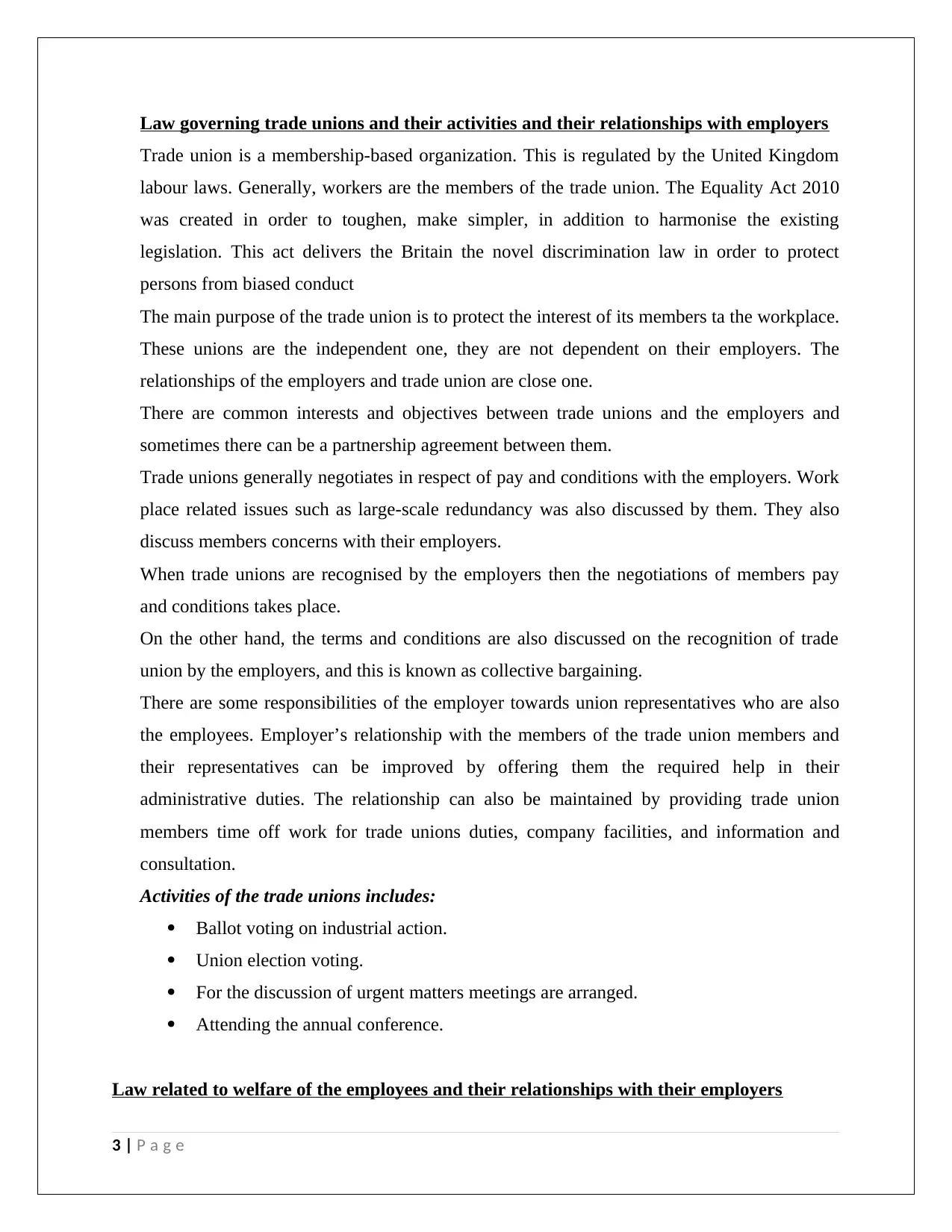
Law governing trade unions and their activities and their relationships with employers
Trade union is a membership-based organization. This is regulated by the United Kingdom
labour laws. Generally, workers are the members of the trade union. The Equality Act 2010
was created in order to toughen, make simpler, in addition to harmonise the existing
legislation. This act delivers the Britain the novel discrimination law in order to protect
persons from biased conduct
The main purpose of the trade union is to protect the interest of its members ta the workplace.
These unions are the independent one, they are not dependent on their employers. The
relationships of the employers and trade union are close one.
There are common interests and objectives between trade unions and the employers and
sometimes there can be a partnership agreement between them.
Trade unions generally negotiates in respect of pay and conditions with the employers. Work
place related issues such as large-scale redundancy was also discussed by them. They also
discuss members concerns with their employers.
When trade unions are recognised by the employers then the negotiations of members pay
and conditions takes place.
On the other hand, the terms and conditions are also discussed on the recognition of trade
union by the employers, and this is known as collective bargaining.
There are some responsibilities of the employer towards union representatives who are also
the employees. Employer’s relationship with the members of the trade union members and
their representatives can be improved by offering them the required help in their
administrative duties. The relationship can also be maintained by providing trade union
members time off work for trade unions duties, company facilities, and information and
consultation.
Activities of the trade unions includes:
Ballot voting on industrial action.
Union election voting.
For the discussion of urgent matters meetings are arranged.
Attending the annual conference.
Law related to welfare of the employees and their relationships with their employers
3 | P a g e
Trade union is a membership-based organization. This is regulated by the United Kingdom
labour laws. Generally, workers are the members of the trade union. The Equality Act 2010
was created in order to toughen, make simpler, in addition to harmonise the existing
legislation. This act delivers the Britain the novel discrimination law in order to protect
persons from biased conduct
The main purpose of the trade union is to protect the interest of its members ta the workplace.
These unions are the independent one, they are not dependent on their employers. The
relationships of the employers and trade union are close one.
There are common interests and objectives between trade unions and the employers and
sometimes there can be a partnership agreement between them.
Trade unions generally negotiates in respect of pay and conditions with the employers. Work
place related issues such as large-scale redundancy was also discussed by them. They also
discuss members concerns with their employers.
When trade unions are recognised by the employers then the negotiations of members pay
and conditions takes place.
On the other hand, the terms and conditions are also discussed on the recognition of trade
union by the employers, and this is known as collective bargaining.
There are some responsibilities of the employer towards union representatives who are also
the employees. Employer’s relationship with the members of the trade union members and
their representatives can be improved by offering them the required help in their
administrative duties. The relationship can also be maintained by providing trade union
members time off work for trade unions duties, company facilities, and information and
consultation.
Activities of the trade unions includes:
Ballot voting on industrial action.
Union election voting.
For the discussion of urgent matters meetings are arranged.
Attending the annual conference.
Law related to welfare of the employees and their relationships with their employers
3 | P a g e
Secure Best Marks with AI Grader
Need help grading? Try our AI Grader for instant feedback on your assignments.
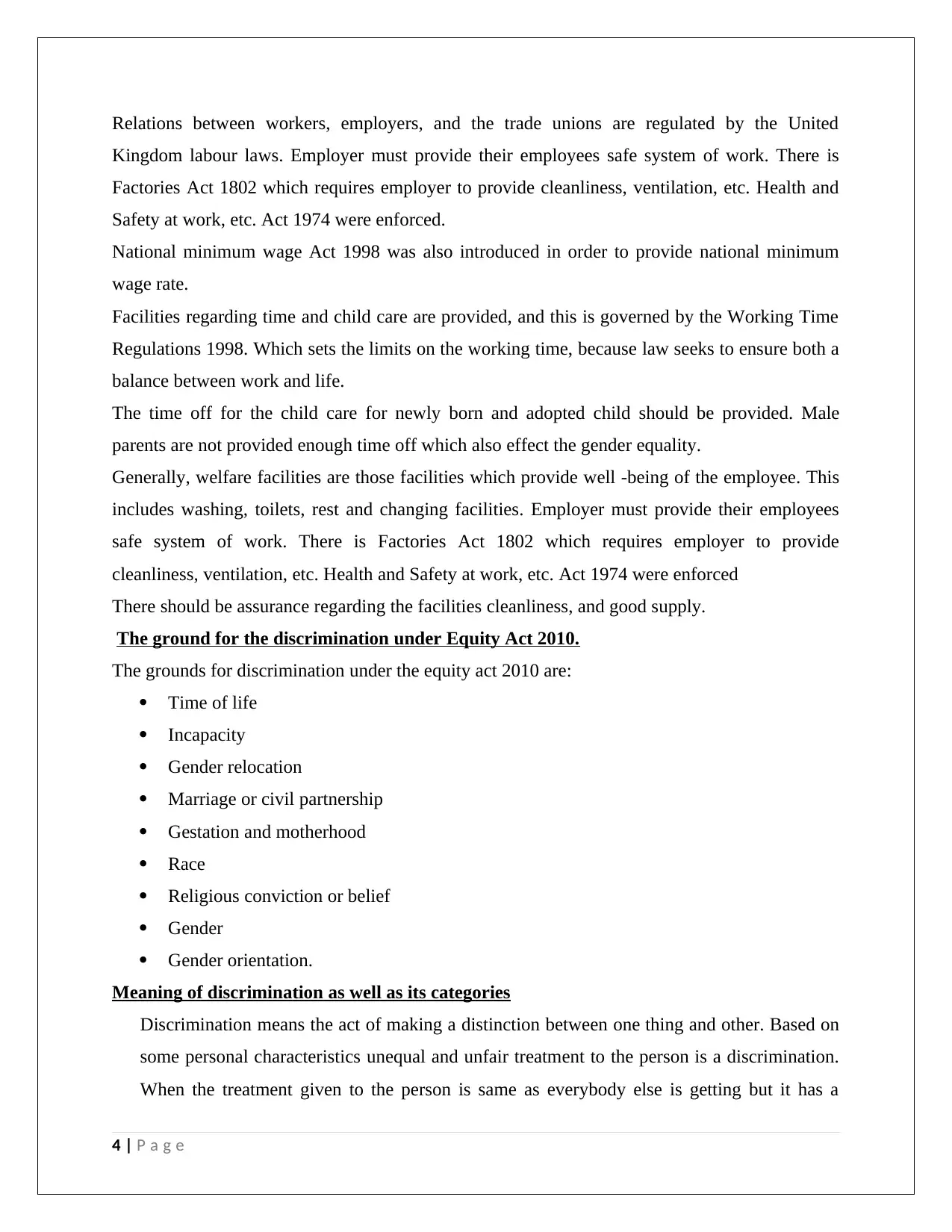
Relations between workers, employers, and the trade unions are regulated by the United
Kingdom labour laws. Employer must provide their employees safe system of work. There is
Factories Act 1802 which requires employer to provide cleanliness, ventilation, etc. Health and
Safety at work, etc. Act 1974 were enforced.
National minimum wage Act 1998 was also introduced in order to provide national minimum
wage rate.
Facilities regarding time and child care are provided, and this is governed by the Working Time
Regulations 1998. Which sets the limits on the working time, because law seeks to ensure both a
balance between work and life.
The time off for the child care for newly born and adopted child should be provided. Male
parents are not provided enough time off which also effect the gender equality.
Generally, welfare facilities are those facilities which provide well -being of the employee. This
includes washing, toilets, rest and changing facilities. Employer must provide their employees
safe system of work. There is Factories Act 1802 which requires employer to provide
cleanliness, ventilation, etc. Health and Safety at work, etc. Act 1974 were enforced
There should be assurance regarding the facilities cleanliness, and good supply.
The ground for the discrimination under Equity Act 2010.
The grounds for discrimination under the equity act 2010 are:
Time of life
Incapacity
Gender relocation
Marriage or civil partnership
Gestation and motherhood
Race
Religious conviction or belief
Gender
Gender orientation.
Meaning of discrimination as well as its categories
Discrimination means the act of making a distinction between one thing and other. Based on
some personal characteristics unequal and unfair treatment to the person is a discrimination.
When the treatment given to the person is same as everybody else is getting but it has a
4 | P a g e
Kingdom labour laws. Employer must provide their employees safe system of work. There is
Factories Act 1802 which requires employer to provide cleanliness, ventilation, etc. Health and
Safety at work, etc. Act 1974 were enforced.
National minimum wage Act 1998 was also introduced in order to provide national minimum
wage rate.
Facilities regarding time and child care are provided, and this is governed by the Working Time
Regulations 1998. Which sets the limits on the working time, because law seeks to ensure both a
balance between work and life.
The time off for the child care for newly born and adopted child should be provided. Male
parents are not provided enough time off which also effect the gender equality.
Generally, welfare facilities are those facilities which provide well -being of the employee. This
includes washing, toilets, rest and changing facilities. Employer must provide their employees
safe system of work. There is Factories Act 1802 which requires employer to provide
cleanliness, ventilation, etc. Health and Safety at work, etc. Act 1974 were enforced
There should be assurance regarding the facilities cleanliness, and good supply.
The ground for the discrimination under Equity Act 2010.
The grounds for discrimination under the equity act 2010 are:
Time of life
Incapacity
Gender relocation
Marriage or civil partnership
Gestation and motherhood
Race
Religious conviction or belief
Gender
Gender orientation.
Meaning of discrimination as well as its categories
Discrimination means the act of making a distinction between one thing and other. Based on
some personal characteristics unequal and unfair treatment to the person is a discrimination.
When the treatment given to the person is same as everybody else is getting but it has a
4 | P a g e
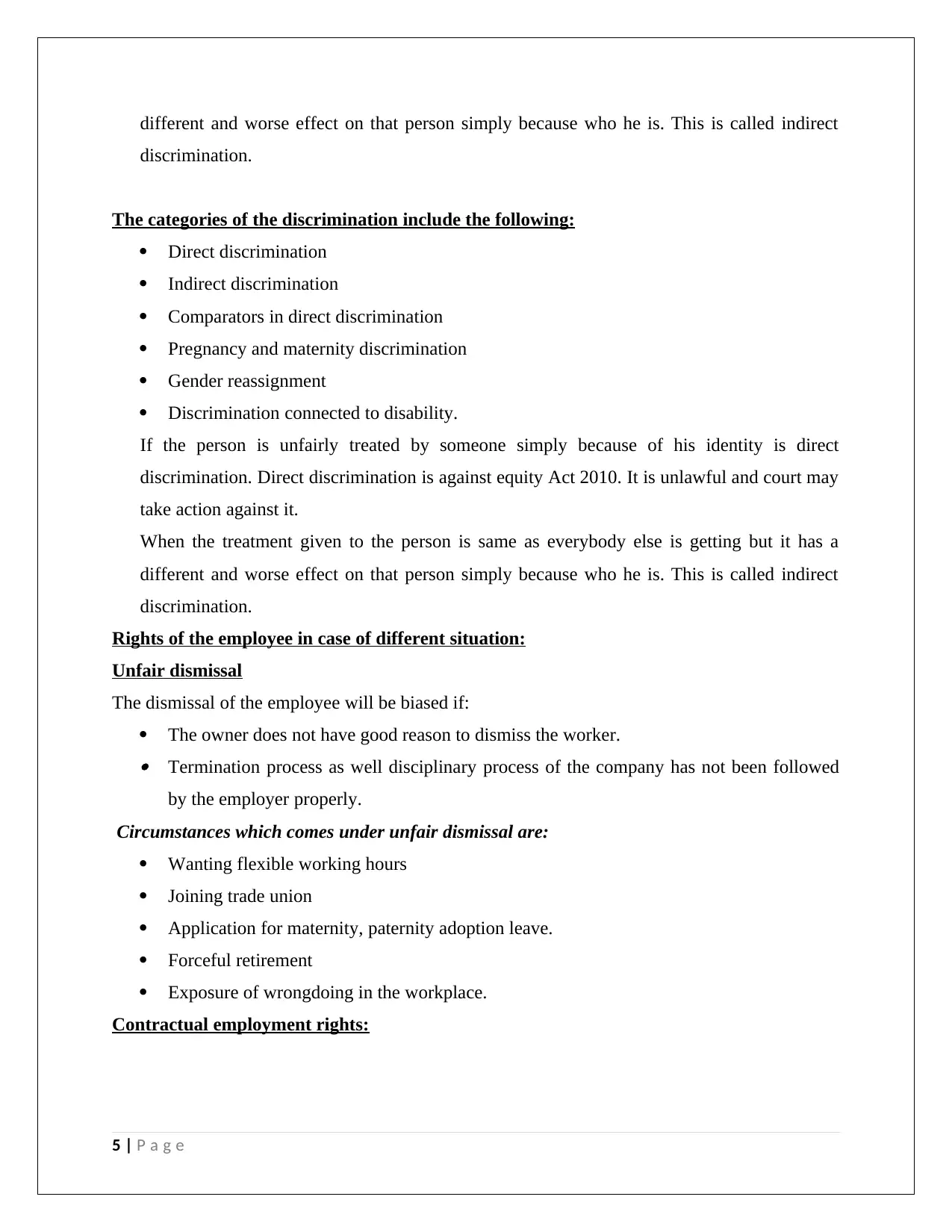
different and worse effect on that person simply because who he is. This is called indirect
discrimination.
The categories of the discrimination include the following:
Direct discrimination
Indirect discrimination
Comparators in direct discrimination
Pregnancy and maternity discrimination
Gender reassignment
Discrimination connected to disability.
If the person is unfairly treated by someone simply because of his identity is direct
discrimination. Direct discrimination is against equity Act 2010. It is unlawful and court may
take action against it.
When the treatment given to the person is same as everybody else is getting but it has a
different and worse effect on that person simply because who he is. This is called indirect
discrimination.
Rights of the employee in case of different situation:
Unfair dismissal
The dismissal of the employee will be biased if:
The owner does not have good reason to dismiss the worker. Termination process as well disciplinary process of the company has not been followed
by the employer properly.
Circumstances which comes under unfair dismissal are:
Wanting flexible working hours
Joining trade union
Application for maternity, paternity adoption leave.
Forceful retirement
Exposure of wrongdoing in the workplace.
Contractual employment rights:
5 | P a g e
discrimination.
The categories of the discrimination include the following:
Direct discrimination
Indirect discrimination
Comparators in direct discrimination
Pregnancy and maternity discrimination
Gender reassignment
Discrimination connected to disability.
If the person is unfairly treated by someone simply because of his identity is direct
discrimination. Direct discrimination is against equity Act 2010. It is unlawful and court may
take action against it.
When the treatment given to the person is same as everybody else is getting but it has a
different and worse effect on that person simply because who he is. This is called indirect
discrimination.
Rights of the employee in case of different situation:
Unfair dismissal
The dismissal of the employee will be biased if:
The owner does not have good reason to dismiss the worker. Termination process as well disciplinary process of the company has not been followed
by the employer properly.
Circumstances which comes under unfair dismissal are:
Wanting flexible working hours
Joining trade union
Application for maternity, paternity adoption leave.
Forceful retirement
Exposure of wrongdoing in the workplace.
Contractual employment rights:
5 | P a g e
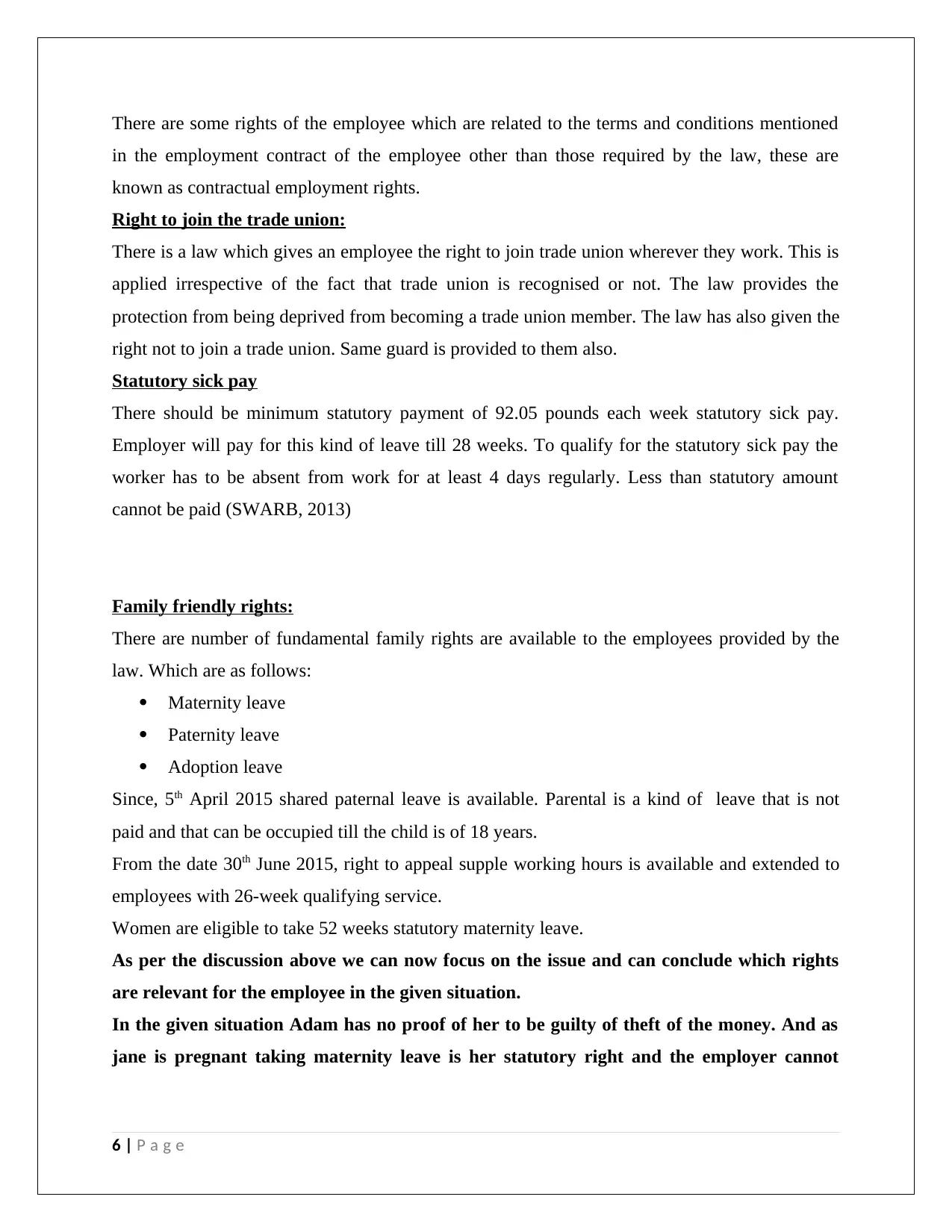
There are some rights of the employee which are related to the terms and conditions mentioned
in the employment contract of the employee other than those required by the law, these are
known as contractual employment rights.
Right to join the trade union:
There is a law which gives an employee the right to join trade union wherever they work. This is
applied irrespective of the fact that trade union is recognised or not. The law provides the
protection from being deprived from becoming a trade union member. The law has also given the
right not to join a trade union. Same guard is provided to them also.
Statutory sick pay
There should be minimum statutory payment of 92.05 pounds each week statutory sick pay.
Employer will pay for this kind of leave till 28 weeks. To qualify for the statutory sick pay the
worker has to be absent from work for at least 4 days regularly. Less than statutory amount
cannot be paid (SWARB, 2013)
Family friendly rights:
There are number of fundamental family rights are available to the employees provided by the
law. Which are as follows:
Maternity leave
Paternity leave
Adoption leave
Since, 5th April 2015 shared paternal leave is available. Parental is a kind of leave that is not
paid and that can be occupied till the child is of 18 years.
From the date 30th June 2015, right to appeal supple working hours is available and extended to
employees with 26-week qualifying service.
Women are eligible to take 52 weeks statutory maternity leave.
As per the discussion above we can now focus on the issue and can conclude which rights
are relevant for the employee in the given situation.
In the given situation Adam has no proof of her to be guilty of theft of the money. And as
jane is pregnant taking maternity leave is her statutory right and the employer cannot
6 | P a g e
in the employment contract of the employee other than those required by the law, these are
known as contractual employment rights.
Right to join the trade union:
There is a law which gives an employee the right to join trade union wherever they work. This is
applied irrespective of the fact that trade union is recognised or not. The law provides the
protection from being deprived from becoming a trade union member. The law has also given the
right not to join a trade union. Same guard is provided to them also.
Statutory sick pay
There should be minimum statutory payment of 92.05 pounds each week statutory sick pay.
Employer will pay for this kind of leave till 28 weeks. To qualify for the statutory sick pay the
worker has to be absent from work for at least 4 days regularly. Less than statutory amount
cannot be paid (SWARB, 2013)
Family friendly rights:
There are number of fundamental family rights are available to the employees provided by the
law. Which are as follows:
Maternity leave
Paternity leave
Adoption leave
Since, 5th April 2015 shared paternal leave is available. Parental is a kind of leave that is not
paid and that can be occupied till the child is of 18 years.
From the date 30th June 2015, right to appeal supple working hours is available and extended to
employees with 26-week qualifying service.
Women are eligible to take 52 weeks statutory maternity leave.
As per the discussion above we can now focus on the issue and can conclude which rights
are relevant for the employee in the given situation.
In the given situation Adam has no proof of her to be guilty of theft of the money. And as
jane is pregnant taking maternity leave is her statutory right and the employer cannot
6 | P a g e
Paraphrase This Document
Need a fresh take? Get an instant paraphrase of this document with our AI Paraphraser
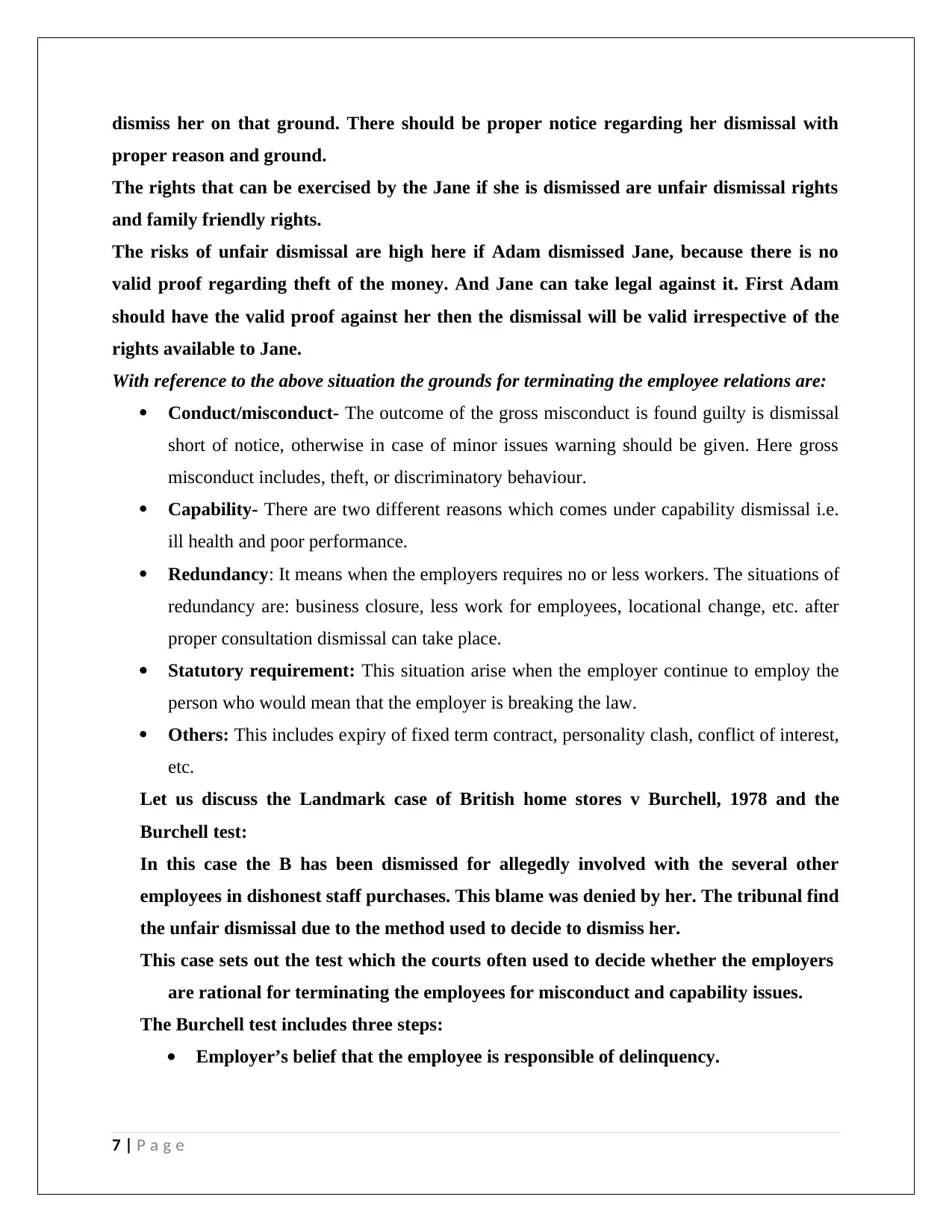
dismiss her on that ground. There should be proper notice regarding her dismissal with
proper reason and ground.
The rights that can be exercised by the Jane if she is dismissed are unfair dismissal rights
and family friendly rights.
The risks of unfair dismissal are high here if Adam dismissed Jane, because there is no
valid proof regarding theft of the money. And Jane can take legal against it. First Adam
should have the valid proof against her then the dismissal will be valid irrespective of the
rights available to Jane.
With reference to the above situation the grounds for terminating the employee relations are:
Conduct/misconduct- The outcome of the gross misconduct is found guilty is dismissal
short of notice, otherwise in case of minor issues warning should be given. Here gross
misconduct includes, theft, or discriminatory behaviour.
Capability- There are two different reasons which comes under capability dismissal i.e.
ill health and poor performance.
Redundancy: It means when the employers requires no or less workers. The situations of
redundancy are: business closure, less work for employees, locational change, etc. after
proper consultation dismissal can take place.
Statutory requirement: This situation arise when the employer continue to employ the
person who would mean that the employer is breaking the law.
Others: This includes expiry of fixed term contract, personality clash, conflict of interest,
etc.
Let us discuss the Landmark case of British home stores v Burchell, 1978 and the
Burchell test:
In this case the B has been dismissed for allegedly involved with the several other
employees in dishonest staff purchases. This blame was denied by her. The tribunal find
the unfair dismissal due to the method used to decide to dismiss her.
This case sets out the test which the courts often used to decide whether the employers
are rational for terminating the employees for misconduct and capability issues.
The Burchell test includes three steps:
Employer’s belief that the employee is responsible of delinquency.
7 | P a g e
proper reason and ground.
The rights that can be exercised by the Jane if she is dismissed are unfair dismissal rights
and family friendly rights.
The risks of unfair dismissal are high here if Adam dismissed Jane, because there is no
valid proof regarding theft of the money. And Jane can take legal against it. First Adam
should have the valid proof against her then the dismissal will be valid irrespective of the
rights available to Jane.
With reference to the above situation the grounds for terminating the employee relations are:
Conduct/misconduct- The outcome of the gross misconduct is found guilty is dismissal
short of notice, otherwise in case of minor issues warning should be given. Here gross
misconduct includes, theft, or discriminatory behaviour.
Capability- There are two different reasons which comes under capability dismissal i.e.
ill health and poor performance.
Redundancy: It means when the employers requires no or less workers. The situations of
redundancy are: business closure, less work for employees, locational change, etc. after
proper consultation dismissal can take place.
Statutory requirement: This situation arise when the employer continue to employ the
person who would mean that the employer is breaking the law.
Others: This includes expiry of fixed term contract, personality clash, conflict of interest,
etc.
Let us discuss the Landmark case of British home stores v Burchell, 1978 and the
Burchell test:
In this case the B has been dismissed for allegedly involved with the several other
employees in dishonest staff purchases. This blame was denied by her. The tribunal find
the unfair dismissal due to the method used to decide to dismiss her.
This case sets out the test which the courts often used to decide whether the employers
are rational for terminating the employees for misconduct and capability issues.
The Burchell test includes three steps:
Employer’s belief that the employee is responsible of delinquency.
7 | P a g e
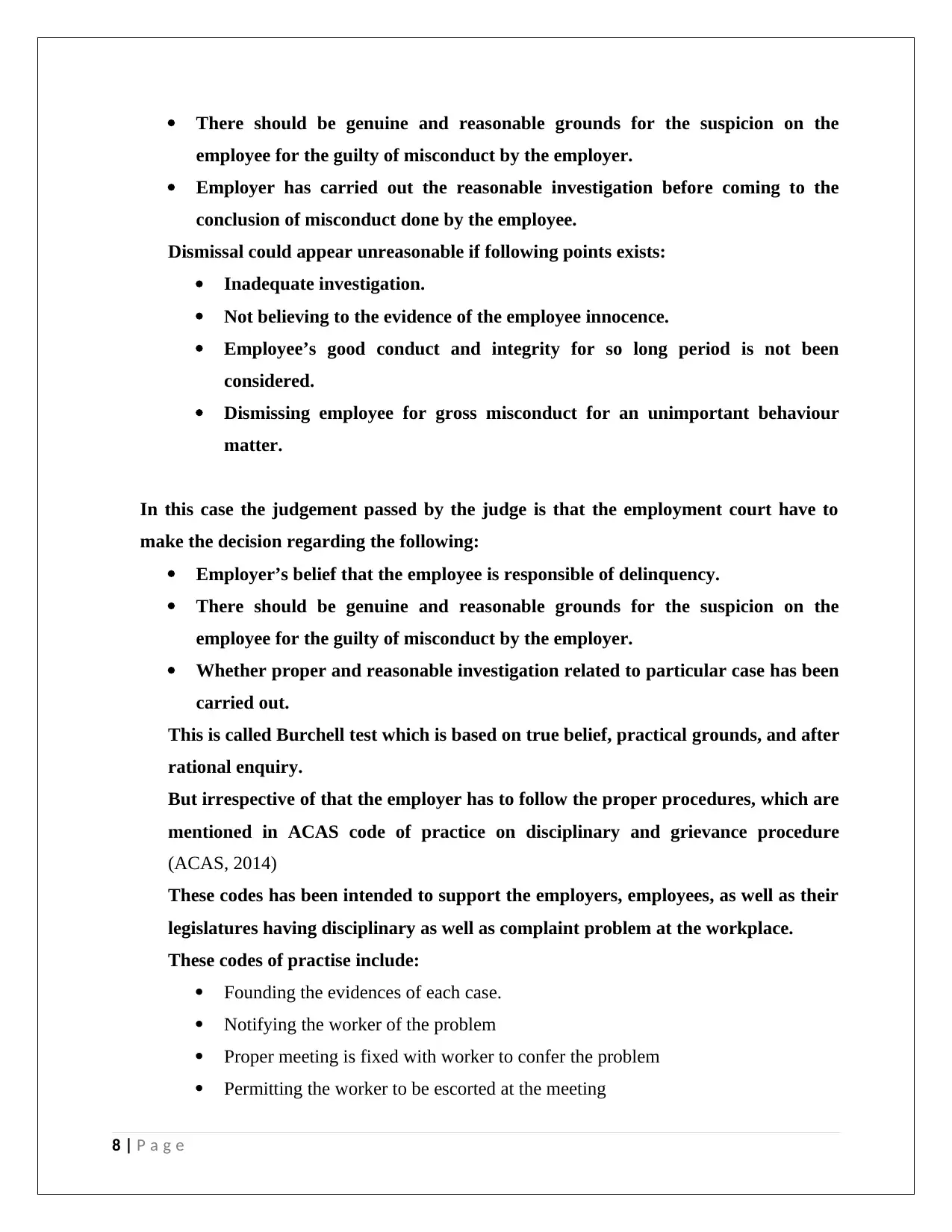
There should be genuine and reasonable grounds for the suspicion on the
employee for the guilty of misconduct by the employer.
Employer has carried out the reasonable investigation before coming to the
conclusion of misconduct done by the employee.
Dismissal could appear unreasonable if following points exists:
Inadequate investigation.
Not believing to the evidence of the employee innocence.
Employee’s good conduct and integrity for so long period is not been
considered.
Dismissing employee for gross misconduct for an unimportant behaviour
matter.
In this case the judgement passed by the judge is that the employment court have to
make the decision regarding the following:
Employer’s belief that the employee is responsible of delinquency.
There should be genuine and reasonable grounds for the suspicion on the
employee for the guilty of misconduct by the employer.
Whether proper and reasonable investigation related to particular case has been
carried out.
This is called Burchell test which is based on true belief, practical grounds, and after
rational enquiry.
But irrespective of that the employer has to follow the proper procedures, which are
mentioned in ACAS code of practice on disciplinary and grievance procedure
(ACAS, 2014)
These codes has been intended to support the employers, employees, as well as their
legislatures having disciplinary as well as complaint problem at the workplace.
These codes of practise include:
Founding the evidences of each case.
Notifying the worker of the problem
Proper meeting is fixed with worker to confer the problem
Permitting the worker to be escorted at the meeting
8 | P a g e
employee for the guilty of misconduct by the employer.
Employer has carried out the reasonable investigation before coming to the
conclusion of misconduct done by the employee.
Dismissal could appear unreasonable if following points exists:
Inadequate investigation.
Not believing to the evidence of the employee innocence.
Employee’s good conduct and integrity for so long period is not been
considered.
Dismissing employee for gross misconduct for an unimportant behaviour
matter.
In this case the judgement passed by the judge is that the employment court have to
make the decision regarding the following:
Employer’s belief that the employee is responsible of delinquency.
There should be genuine and reasonable grounds for the suspicion on the
employee for the guilty of misconduct by the employer.
Whether proper and reasonable investigation related to particular case has been
carried out.
This is called Burchell test which is based on true belief, practical grounds, and after
rational enquiry.
But irrespective of that the employer has to follow the proper procedures, which are
mentioned in ACAS code of practice on disciplinary and grievance procedure
(ACAS, 2014)
These codes has been intended to support the employers, employees, as well as their
legislatures having disciplinary as well as complaint problem at the workplace.
These codes of practise include:
Founding the evidences of each case.
Notifying the worker of the problem
Proper meeting is fixed with worker to confer the problem
Permitting the worker to be escorted at the meeting
8 | P a g e
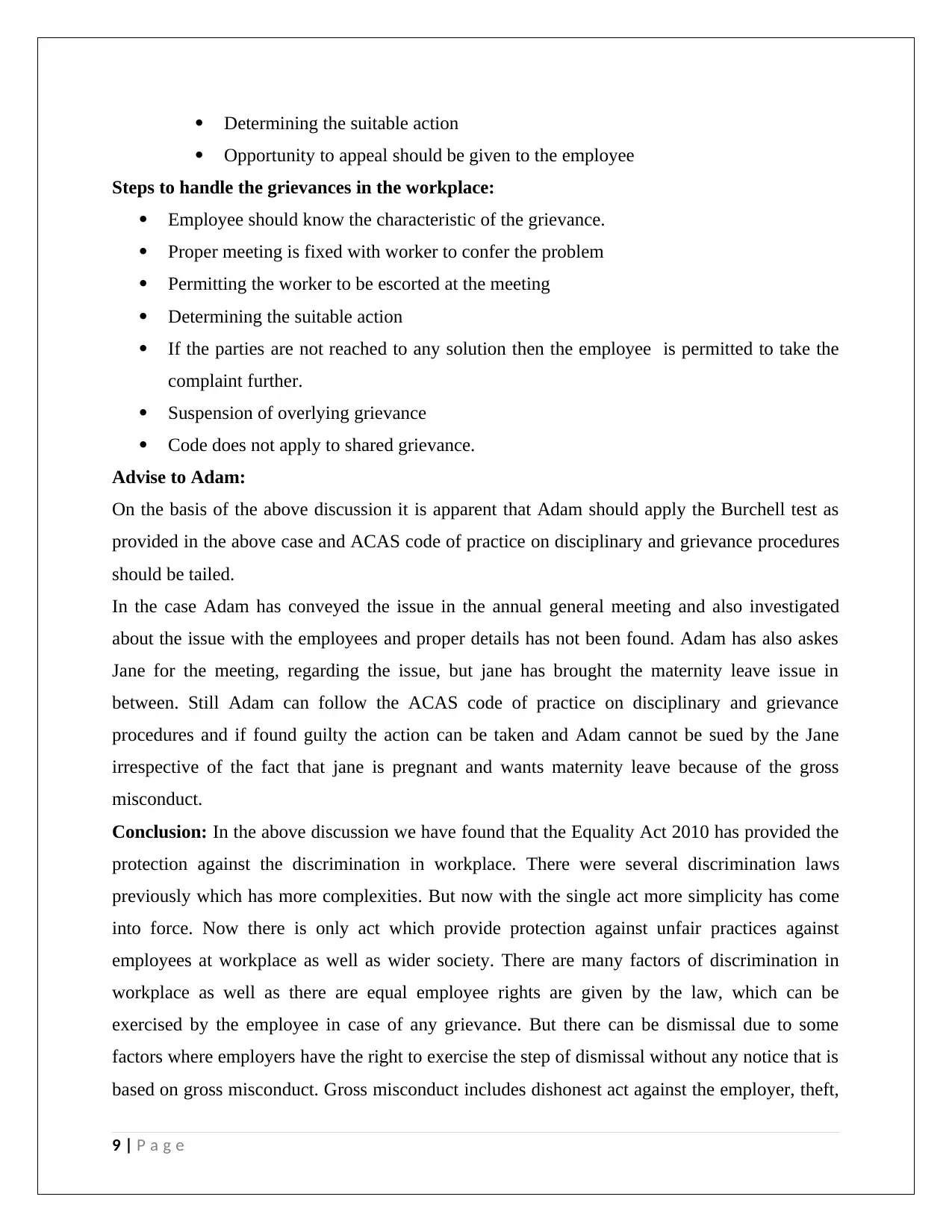
Determining the suitable action
Opportunity to appeal should be given to the employee
Steps to handle the grievances in the workplace:
Employee should know the characteristic of the grievance.
Proper meeting is fixed with worker to confer the problem
Permitting the worker to be escorted at the meeting
Determining the suitable action
If the parties are not reached to any solution then the employee is permitted to take the
complaint further.
Suspension of overlying grievance
Code does not apply to shared grievance.
Advise to Adam:
On the basis of the above discussion it is apparent that Adam should apply the Burchell test as
provided in the above case and ACAS code of practice on disciplinary and grievance procedures
should be tailed.
In the case Adam has conveyed the issue in the annual general meeting and also investigated
about the issue with the employees and proper details has not been found. Adam has also askes
Jane for the meeting, regarding the issue, but jane has brought the maternity leave issue in
between. Still Adam can follow the ACAS code of practice on disciplinary and grievance
procedures and if found guilty the action can be taken and Adam cannot be sued by the Jane
irrespective of the fact that jane is pregnant and wants maternity leave because of the gross
misconduct.
Conclusion: In the above discussion we have found that the Equality Act 2010 has provided the
protection against the discrimination in workplace. There were several discrimination laws
previously which has more complexities. But now with the single act more simplicity has come
into force. Now there is only act which provide protection against unfair practices against
employees at workplace as well as wider society. There are many factors of discrimination in
workplace as well as there are equal employee rights are given by the law, which can be
exercised by the employee in case of any grievance. But there can be dismissal due to some
factors where employers have the right to exercise the step of dismissal without any notice that is
based on gross misconduct. Gross misconduct includes dishonest act against the employer, theft,
9 | P a g e
Opportunity to appeal should be given to the employee
Steps to handle the grievances in the workplace:
Employee should know the characteristic of the grievance.
Proper meeting is fixed with worker to confer the problem
Permitting the worker to be escorted at the meeting
Determining the suitable action
If the parties are not reached to any solution then the employee is permitted to take the
complaint further.
Suspension of overlying grievance
Code does not apply to shared grievance.
Advise to Adam:
On the basis of the above discussion it is apparent that Adam should apply the Burchell test as
provided in the above case and ACAS code of practice on disciplinary and grievance procedures
should be tailed.
In the case Adam has conveyed the issue in the annual general meeting and also investigated
about the issue with the employees and proper details has not been found. Adam has also askes
Jane for the meeting, regarding the issue, but jane has brought the maternity leave issue in
between. Still Adam can follow the ACAS code of practice on disciplinary and grievance
procedures and if found guilty the action can be taken and Adam cannot be sued by the Jane
irrespective of the fact that jane is pregnant and wants maternity leave because of the gross
misconduct.
Conclusion: In the above discussion we have found that the Equality Act 2010 has provided the
protection against the discrimination in workplace. There were several discrimination laws
previously which has more complexities. But now with the single act more simplicity has come
into force. Now there is only act which provide protection against unfair practices against
employees at workplace as well as wider society. There are many factors of discrimination in
workplace as well as there are equal employee rights are given by the law, which can be
exercised by the employee in case of any grievance. But there can be dismissal due to some
factors where employers have the right to exercise the step of dismissal without any notice that is
based on gross misconduct. Gross misconduct includes dishonest act against the employer, theft,
9 | P a g e
Secure Best Marks with AI Grader
Need help grading? Try our AI Grader for instant feedback on your assignments.
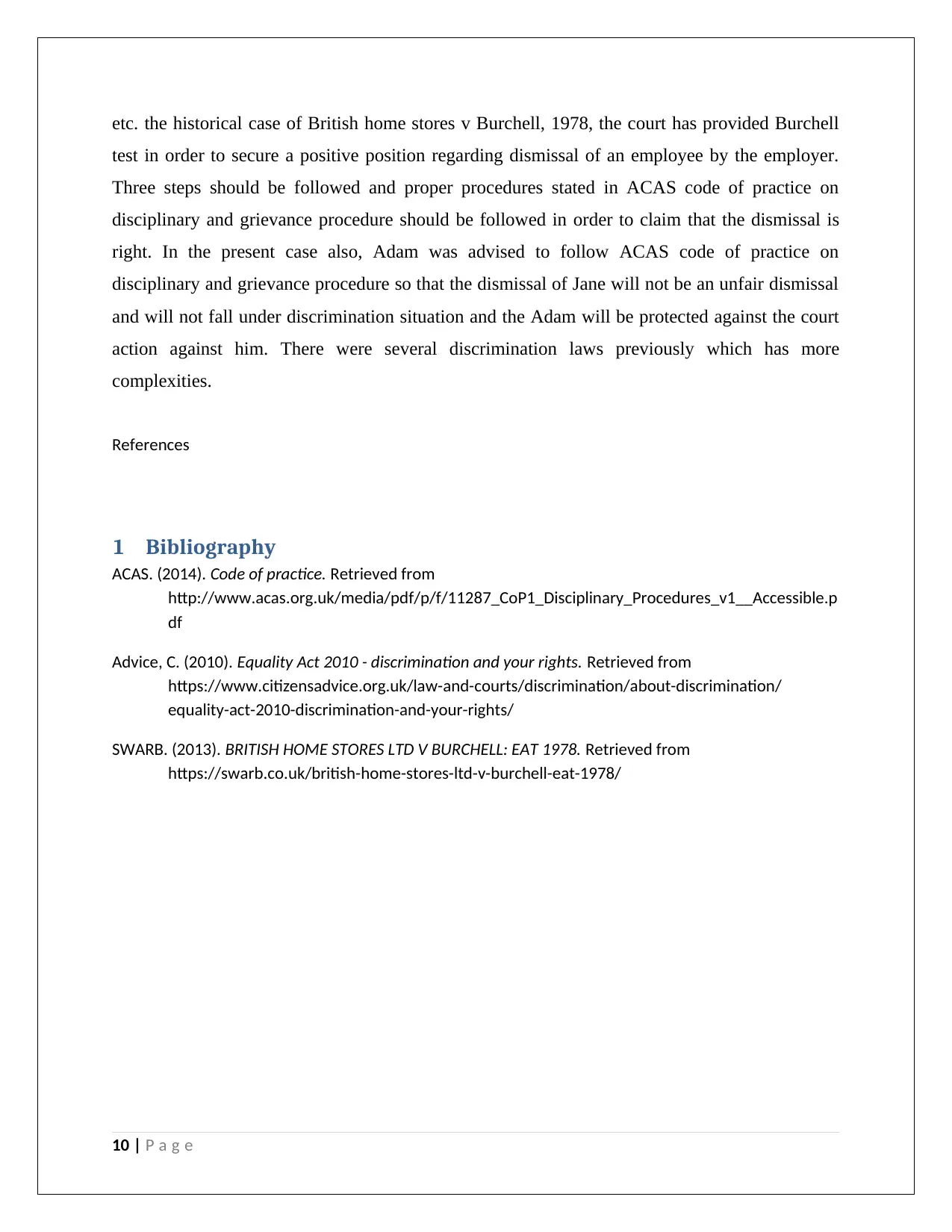
etc. the historical case of British home stores v Burchell, 1978, the court has provided Burchell
test in order to secure a positive position regarding dismissal of an employee by the employer.
Three steps should be followed and proper procedures stated in ACAS code of practice on
disciplinary and grievance procedure should be followed in order to claim that the dismissal is
right. In the present case also, Adam was advised to follow ACAS code of practice on
disciplinary and grievance procedure so that the dismissal of Jane will not be an unfair dismissal
and will not fall under discrimination situation and the Adam will be protected against the court
action against him. There were several discrimination laws previously which has more
complexities.
References
1 Bibliography
ACAS. (2014). Code of practice. Retrieved from
http://www.acas.org.uk/media/pdf/p/f/11287_CoP1_Disciplinary_Procedures_v1__Accessible.p
df
Advice, C. (2010). Equality Act 2010 - discrimination and your rights. Retrieved from
https://www.citizensadvice.org.uk/law-and-courts/discrimination/about-discrimination/
equality-act-2010-discrimination-and-your-rights/
SWARB. (2013). BRITISH HOME STORES LTD V BURCHELL: EAT 1978. Retrieved from
https://swarb.co.uk/british-home-stores-ltd-v-burchell-eat-1978/
10 | P a g e
test in order to secure a positive position regarding dismissal of an employee by the employer.
Three steps should be followed and proper procedures stated in ACAS code of practice on
disciplinary and grievance procedure should be followed in order to claim that the dismissal is
right. In the present case also, Adam was advised to follow ACAS code of practice on
disciplinary and grievance procedure so that the dismissal of Jane will not be an unfair dismissal
and will not fall under discrimination situation and the Adam will be protected against the court
action against him. There were several discrimination laws previously which has more
complexities.
References
1 Bibliography
ACAS. (2014). Code of practice. Retrieved from
http://www.acas.org.uk/media/pdf/p/f/11287_CoP1_Disciplinary_Procedures_v1__Accessible.p
df
Advice, C. (2010). Equality Act 2010 - discrimination and your rights. Retrieved from
https://www.citizensadvice.org.uk/law-and-courts/discrimination/about-discrimination/
equality-act-2010-discrimination-and-your-rights/
SWARB. (2013). BRITISH HOME STORES LTD V BURCHELL: EAT 1978. Retrieved from
https://swarb.co.uk/british-home-stores-ltd-v-burchell-eat-1978/
10 | P a g e
1 out of 11
Related Documents
Your All-in-One AI-Powered Toolkit for Academic Success.
+13062052269
info@desklib.com
Available 24*7 on WhatsApp / Email
![[object Object]](/_next/static/media/star-bottom.7253800d.svg)
Unlock your academic potential
© 2024 | Zucol Services PVT LTD | All rights reserved.





